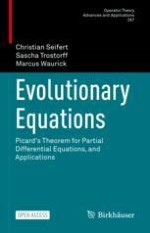11.1 The Notion of Exponential Stability

 the solution U is given by
the solution U is given by  is continuous and satisfies
is continuous and satisfies
11.2 A Criterion for Exponential Stability of Parabolic-Type Equations


 .
.
 . By Proposition 6.2.3 for x ∈ H
1 we estimate
. By Proposition 6.2.3 for x ∈ H
1 we estimate 

 . We set
. We set 
11.3 Three Exponentially Stable Models for Heat Conduction

 and
and
 , we arrive at
, we arrive at  , we derive from the heat flux balance
, we derive from the heat flux balance 
 . This yields
. This yields 


 is boundedly invertible and the solution operators associated with (11.2) are exponentially stable.
is boundedly invertible and the solution operators associated with (11.2) are exponentially stable.
 ,
,
 for \(z\in \mathbb {C}\) and C given by (11.3). Since \(\operatorname {Re}\widetilde {a}^{-1}\geqslant \frac {c_{1}}{\left \Vert \widetilde {a} \right \Vert ^{2}}\), Theorem 11.2.1 is applicable and we derive the exponential stability. □
for \(z\in \mathbb {C}\) and C given by (11.3). Since \(\operatorname {Re}\widetilde {a}^{-1}\geqslant \frac {c_{1}}{\left \Vert \widetilde {a} \right \Vert ^{2}}\), Theorem 11.2.1 is applicable and we derive the exponential stability. □ and
and
 for j ∈{1, 2}. Moreover, we assume that there exists c > 0 such that
for j ∈{1, 2}. Moreover, we assume that there exists c > 0 such that  . Hence,
. Hence, 
 , the dual phase lag model may be written as
, the dual phase lag model may be written as  and
and 
 we compute
we compute 11.4 Exponential Stability for Hyperbolic-Type Equations

 and
and
 as new unknowns, we end up with an equation of the form
as new unknowns, we end up with an equation of the form 
 , which is boundedly invertible by Poincaré’s inequality (see Proposition 11.3.1 and Lemma 11.3.4) and
, which is boundedly invertible by Poincaré’s inequality (see Proposition 11.3.1 and Lemma 11.3.4) and  and
and
 Then we formally get
Then we formally get 
11.5 A Criterion for Exponential Stability of Hyperbolic-Type Equations
 and
and
 for j ∈{0, 1}.
for j ∈{0, 1}. showing the assertion. □
showing the assertion. □
 , we infer that T
d is defined on the whole \(\mathbb {C}_{\operatorname {Re}>-\mu }\) despite a discrete set. Since T
d is holomorphic and bounded, Riemann’s theorem on removable singularities implies that T
d can be extended to a holomorphic and bounded function on \(\mathbb {C}_{\operatorname {Re}>-\mu }\). We denote this extension again by T
d. In particular, T
d is a material law with \(s_{b}(T_d)\leqslant -\mu \). Let now \(\rho \in \left [0,\mu \right )\) and \((f,g)\in L_{2,\nu }(\mathbb {R};H_{0}\oplus H_{1})\cap L_{2,-\rho }(\mathbb {R};H_{0}\oplus H_{1})\), where ν > 0 is large enough to ensure well-posedness. By Theorem 5.3.6 we derive
, we infer that T
d is defined on the whole \(\mathbb {C}_{\operatorname {Re}>-\mu }\) despite a discrete set. Since T
d is holomorphic and bounded, Riemann’s theorem on removable singularities implies that T
d can be extended to a holomorphic and bounded function on \(\mathbb {C}_{\operatorname {Re}>-\mu }\). We denote this extension again by T
d. In particular, T
d is a material law with \(s_{b}(T_d)\leqslant -\mu \). Let now \(\rho \in \left [0,\mu \right )\) and \((f,g)\in L_{2,\nu }(\mathbb {R};H_{0}\oplus H_{1})\cap L_{2,-\rho }(\mathbb {R};H_{0}\oplus H_{1})\), where ν > 0 is large enough to ensure well-posedness. By Theorem 5.3.6 we derive 11.6 Examples of Exponentially Stable Hyperbolic Problems

 ) we have that
) we have that 



 for some Ω0 ⊆ Ω and \(\operatorname {Re} M_{1}\geqslant c\). In this case, Eq. (11.10) is a coupled system of the damped wave equation inside Ω0 and of the heat equation outside Ω0.
for some Ω0 ⊆ Ω and \(\operatorname {Re} M_{1}\geqslant c\). In this case, Eq. (11.10) is a coupled system of the damped wave equation inside Ω0 and of the heat equation outside Ω0.

 and
and  and obtain
and obtain 11.7 Comments
 satisfies the geometric optics condition. This is, for instance, the case if [a > 0] contains a neighbourhood of the boundary ∂ Ω.
satisfies the geometric optics condition. This is, for instance, the case if [a > 0] contains a neighbourhood of the boundary ∂ Ω.
 . Let \(\theta \in L_{2,\nu }(\mathbb {R};L_2(\Omega ))\), \(q\in L_{2,\nu }(\mathbb {R};L_2(\Omega )^d)\) satisfy
. Let \(\theta \in L_{2,\nu }(\mathbb {R};L_2(\Omega ))\), \(q\in L_{2,\nu }(\mathbb {R};L_2(\Omega )^d)\) satisfy 


